In our two months in Peru we volunteered in a Hare Krishna temple, hiked to a beautiful glacial lake, sandboarded in Huacachina, ate at delicious vegan restaurants, joined a multi-day tour in the Amazon rainforest, met wonderful people, listend to pan flute music, and visited Machu Picchu.
We entered Peru in La Tina and hitchhiked to Las Lomas where we slept one night in a hotel. The next morning we hitchhiked to Piura which has one of the biggest markets I have ever been.
Chiclayo
In Chiclayo we stayed in a house that was affected by the flooding in March 2017. So the house was literally falling apart and the walls and blankets were molded. I did not feel very comfortable. But our host was very nice and vegan as well. So we had some nice conversations.
Since there was not much to do in the city we treated ourselves to a massage (25 soles). We explored the huge Mercado Modelo. A market where you can find almost all you need for a good price. And we ate at a vegan restaurant named Loving Hut (10-13 soles per meal). We learnt very early that there were many more Indigenous cultures than just the Incas.
Trujillo
We had a great host in Trujillo who joined us for a walk and to the beautiful Plaza de Armas. Every Sunday people sell second-hand clothes close to the New Market La Union. I bought a pair of trousers for only 1 sol. The Mercado La Hermelinda offers a huge variety of food for a good price.
Our next stop was Nuevo Chimbote which has a nice main plaza. But there was not much to do either. After hitchhiking for two weeks till we arrived at the first place in Peru that was on our original To Visit list – Laguna 69 in Huaraz – we decided to take buses for the rest of Peru. Distances are huge and there is not much in between. A third of the population of Peru (>10 Mio.) lives in Lima. Most of the North of Peru near the coast is desert.
Laguna 69
Located in the National Park Huascarán which offers many different hikes which you can do on your own or with a tour. We stayed in Caraz to be closer to Laguna 69, a glacial lake. Most backpackers stay in Huaraz though. It makes sense to go with a tour (35-50 soles per person for all transport). To go by public transport is around 34-42 soles and involves a change of the bus in Yungay. Our host was a tour guide and we paid him 40 soles. He even made a stop at the beautiful Laguna de Llanganuco.
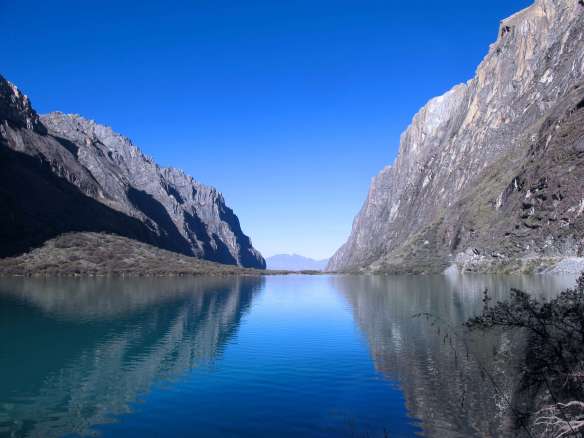
The hike to Laguna 69 is a tough trek but absolutely stunning.
Good to know:
- Laguna 69 is at 4,680 m. You start walking at 3’900 m. Give yourself time to acclimatise to the altitude.
- Hike duration: 3h up, 2h down.
- There are multiple bus stations in Huaraz. Most bus companies departure from the street Jiron Simón Bolívar.
- Take warm clothes with you. It gets cold further up and in the late afternoon.
- Pass: You can either buy a 1-day pass for 10 soles or a 21-day pass for 65 soles. It is not possible to buy anything in between.
- If you camp in the national park you can get a ride back to Huaraz with one of the tour buses with empty seats. This costs the same as public transport.
Lima
The capital Lima is a very busy and huge city. Earplugs recommended 😉 During winter, from June to September, the sky is almost always cloudy. I usually do not like big cities. But Lima offers so many things to do and restaurants to eat that we stayed there for a week. My highlight in Lima was the Eureka Café Lúdico. It has hundreds board and card games. You can pick one and a staff member will come to your table and explain all the rules in English or Spanish. I was impressed. We played Cortex and Saboteur.
In the beautiful Reserve Park we spend a romantic evening watching the water fountain show. There are many other fountains in the park which are nice to visit before the show. The one called Labyrinth is interactive and the possibility to get wet is high. Open from Tuesday to Sunday. Water show at 19:15, 20:15, and 21:30. Entry is 4 soles.
I highly recommend to explore the alternative artistic neighbourhood Barranco.
Every Saturday from 8:30 am to 2:30 pm there is an organic market – the Bioferia – in the Parque Reducto No. 2 in Miraflores. In Lima are countless restaurants that offer vegan options. Check out TripAdvisor and use the different filters. At the Panadería El Pan De La Chola we had a great brunch. At Tarboush we had the best hummus and falafel since a long time.
We spend a whole afternoon in the art museum MALI. It is huge. Free entry every Thursday from 3pm and last Friday of each month from 5 to 10pm. General: 30 soles. The MATE Mario Testino Museum was very nice and interesting.
On a clear and sunny day it is nice to walk along the Malecon and to visit the Main Square. Much of the nightlife takes place in Calle Berlin. We visited all three Choco Museums in Lima. Because chocolate 😉
Sandboarding in Huacachina
We stayed in Ica. At around noon we went with a collective to the artificial oasis, Huacachina (2.50 soles, 10 Mins.). A very small place that is nice for a few hours. It is possible to swim in the lagoon.
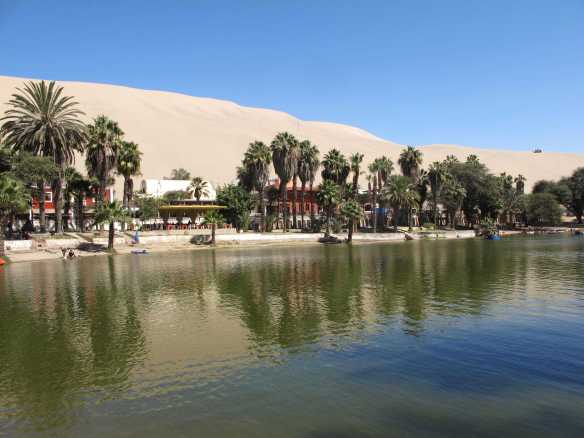
I recommend the 4pm tour as the temperature is cooler then, plus it includes to watch the sunset in the desert (30 soles which includes the entrance to the desert). The ride with the dune buggy was like a rollercoaster.
Cusco
A beautiful city with nice parks high in the Andes Mountains at 3416 m. It got very chilly in the evening. There is a great donation-based walking tour by Free Tours by Foot. The Plaza de Armas is beautiful. One evening we met Maxime from Amsterdam. A Camp Unknown friend we met two years ago at the same festival (Sziget) Drew and I met.
Green Point (100% vegan)
What a delight! Definitely one of the best vegan restaurants we visited so far. Once we ordered the set menu del dia for lunch that comes with a juice, salad bar, soup, choice from one of two main courses, and dessert (15 soles). The second time we ordered from the menu (main courses range from 12-30 soles). Their ceviche (oyster mushrooms) was by far the best I ever ate.
Volunteering in a Hare Krishna temple in Cusco
In Cusco we volunteered for a week in a Hare Krishna temple. It was an interesting experience. Women and men sleep in separate rooms. Not much physical contact allowed. Eating in the kitchen is not allowed. You can only enter the kitchen with a clean mouth. The food is vegetarian and they do not eat eggs because it is the egg of the menstruation and they do not want to risk that the egg might be fertilised. It was really nice that they made us extra meals that are vegan and taught us how to make vegan cheese. Unfortunately we got proteins only once during that week. When I asked them why they eat dairy products they said it is because Krishna loves milk and that is how it is written in the Bhagavad Gita. I like that they aim a detachment from the material world.
In the morning the women clean and make breakfast and the men make bread. When I asked if I could help with the bread one of the female devotee explained to me that it is very hot in the bakery and women are more sensitive than men. The Bhagavad Gita is known for being sexist. But one has to consider the time it was written. Happily many do not take the Bhagavad Gita word for word and know that it is important to adapt to the current society. After the men came back we had a ceremony. At noon or sometimes at 2pm we ate “breakfast”. “Lunch” was at 6pm and sometimes 8pm. There are only two meals per day but we could snack as much as we wanted. After breakfast most people went out and sold the bread on the street. They not have a license but there is a law that moving while selling is okay but we had to watch out for police in orange vests that can confiscate our baskets of bread. I started to paint a wall mandala in the last few days. Their logo with a tree in the middle located in the dining room.
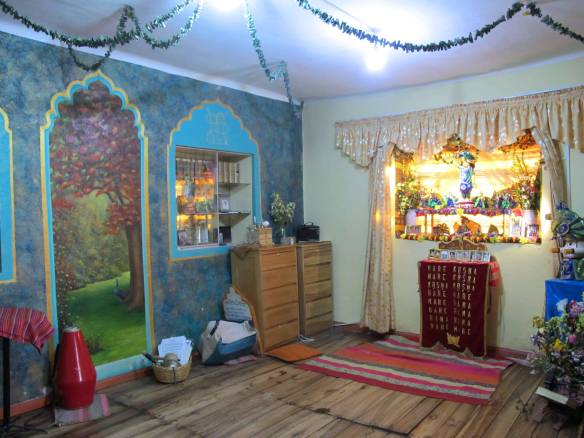
The temple was beautiful. The devotees spent a lot of time decorating it each morning. Having never stayed in a temple, I pictured a calm, quiet area with people meditating. In this temple, it was not like that. In the early morning people were listening to music and in the evening people had mantra (chanting) parties. Many people stayed awake until 1 or 2 am.
Volunteering in Taray in the Sacred Valley
A beautiful place in the nature. Syama our host has the dream of building a retreat centre. There is already a yoga studio, a huge garden, a sweat lodge, a place for meditation, meetings, and group workshops. There is still a lot of work ahead and he has no money. Many of the bathrooms do not work, no hot shower, and the beds are like a taco. I cleaned a lot and started to paint a signboard for the retreat centre. Drew helped in the garden, did some woodwork, and made a website for him.
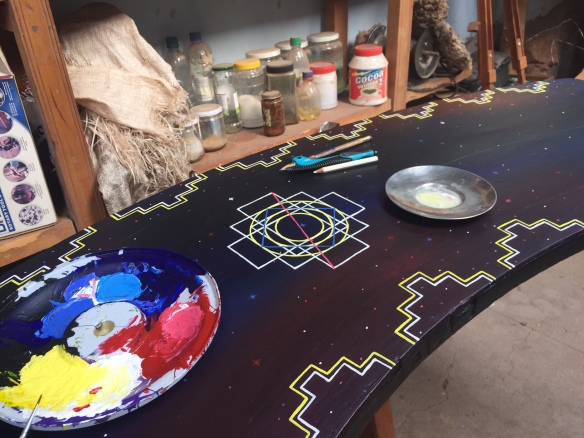
We exchanged four hours of work in the mornings for a room with two beds and food was bought and shared by volunteers. Syama is a devotee of Krishna and is therefore vegetarian (no eggs, as well). Unfortunately, we never saw him buy food. He only offered to gather money from volunteers and then buy food for everyone. It was nice of him to offer to go to get the food but we wish he would have contributed to the food as agreed on. However, we were able to join him one evening for a three hour sauna ritual. That was a very nice and hot experience. I am very grateful for the time we spend at Sonqo Wasi.
Way to Machu Picchu without train
We took a bus from Pisac to Urubamba (3 soles) and then a collectivo to Ollantaytambo (2 soles, 30 Mins.). At Plaza Ollantaytambo the last collectivo directly to hidroelectrica leaves at 10:30 am (25-30 soles, 4h). The only way to get from Hydroelectrica to Aguas Calientes is by foot along the rails (2-2.5 h). A stunning hike. We had a fun time with Tom, an American guy we volunteered with in Taray, who joined us to Machu Picchu. There are actually collectivos that go directly from Hydroelectrica back to Cusco for 30 soles.
Aguas Calientes (2090 m)
We stayed at Casa Machu Picchu in Aguas Calientes (26 soles for a dorm). It had a kitchen to use but they were very loud in the evening. Not a great deal if you want to get up at 4 am the next day. There is also camping for 15 soles each. We bought our ticket to Machu Picchu in Aguas Calientes in the tourist office (150 soles, open until 8pm). The control at the bottom of Machu Picchu opens at 5 am. The hike up takes around 1.5h. Luckily we did not have to wait that long. We were excited to visit the Govinda Restaurant in Aguas Calientes. It has nice vegan options. Aguas Calientes is a touristic but very beautiful little town to walk around.
Machu Picchu (2430 m)
Definitely one of my highlights in Peru. The hike up is tough but extremely rewarding. The morning fog makes the whole experience very mystic. The section of the mountain where Machu Picchu was built provided various challenges. One issue was the seismic activity which made mortar nearly useless. Instead, the Inca cut blocks of stone to fit together perfectly without mortar.
Another issue was heavy rain throughout the year. To prevent landslides and flooding the Inca built terraces that were layered with stone chips, sand, dirt and top soil, to absorb water slowly. A very smart drainage system. Multiple canals and reserves provided water throughout the city. To see all of that with my own eyes was very impressive.
On our way back to Cusco we stayed a few days in Ollantaytambo. A very small, beautiful and peaceful town. There are cobblestones, streams, a small market, nice ruins, and a few cosy restaurants. In Urubamba we stopped at Cerveceria Willkamayu. The brewery turned out to be in the house of a family. They were extremely nice. We were told it is normally closed on a Sunday but they warmly welcomed us into their beautiful garden and even made me a coffee. In Europe or the USA it would be very hard to just open a little brewery in your house. There is a lot of paperwork involved.
Puerto Maldonado (193 m)
Puerto Maldonado is located in the Amazon rainforest and therefore very hot and humid. Mosquito repellent recommended. We watched a beautiful sunset at 5:30 am from the rooftop of our host’s house. The sun is red. For sunset and sunrise.

La Semilla Cafe-Restauant-Pasteleria
Such a great restaurant. Beautiful rooftop terrace with comfortable sofas to relax for a few hours. The staff was very friendly and helpful. They made a vegan pizza for us and substituted avocado for cheese. We had a cappuccino with coconut milk. The smoothie with banana, avocado, chocolate and lucuma was so delicious and filling!

Amazon tour
There are many different agencies close to the Plaza the Armas that offer tours. The tour we booked started at 8:30 am and finishing at 5 pm on the third day (450 soles per person). We had a great time with activities. We went kayaking, zip lining, to the canopy walk, and visited the Monkey Island where we fed the monkeys bananas.
One day we visited Lake Sandoval in the Tambopata National Reserve where we saw an otter family, giant birds, turtles, and countless butterlflies.
In the night we went caiman spotting. At 4:30 am we went with a boat to the parrot and parakeet clay lick. The sunrise and the red macow were impressive.
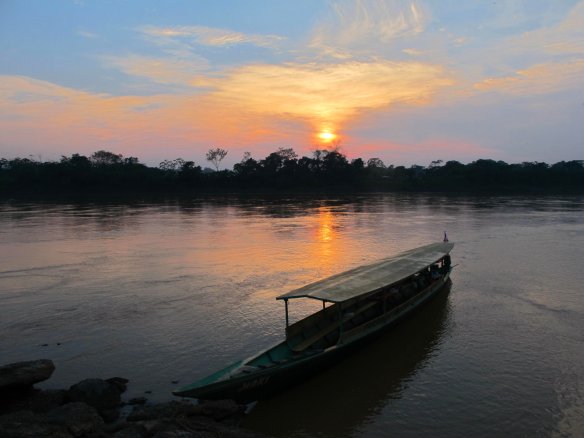
The jungle walk was very interesting since our guide knew a lot about different medicinal plants and animals.
On our last day we visited a native family that consisted of only two men. But we had fun shooting with bow and arrows anyway. Drew hit the tree at his first try.
The accommodation was very clean and comfortable. We had a bungalow with a private bathroom and hot water. Since it was an eco-lodge the electricity was running only a few hours during the day and there was no Wi-Fi. That was nice. I loved to fall asleep with the sound of the jungle. Our lodge had a black spider monkey. Unfortunately I think he had to be in a small cage most of the time. He was very trustful and hugged everybody.
We booked our tour with Paradise Amazon eco lodge & adventure because they promised to serve well-balanced vegetarian food with no lactose – but legumes, avocado, and rice. We were served rice and a few vegetables. No replacement. That left us hungry. Example: While people got Ceviche, we got a plate with ten little pieces of tomato. Luckily we brought bananas and peanuts. When we told the manager there was no sorry, no empathy, and she refused any responsibility for the empty promises. It seems if they have too many bad reviews on TripAdvisor they just change the name. I would not recommend this lodge to vegetarians, vegans, or anyone who does not “eat like a normal person.” – The manager.
Arequipa (2335 m)
The white buildings built from volcanic rocks in the historical centre make this city to one of the prettiest in Peru and the all year round spring like climate makes Arequipa to a very nice destination. We had a very relaxed time and enjoyed delicious food. Free Tours by Foot offers a very nice walking tour.
From a Couchsurfer we bought second-hand a tent and a sleeping bag for Patagonia. Another sleeping bag we bought in the supermarket Metro. The San Camilo market is huge and the place we bought fresh fruits and vegetables. Right in front of the market sells a lady vegetable Empanadas for 1 sol.
El Buda Profano (100% vegan)
A sushi place that attracts people from all over. Even omnivores. Why? Because they serve one of the best sushi I ever ate. I will never forget the taste of the Selva Uramaki: Cucumber, shiitake and avocado topped with mango. I also really liked the Verde Futomaki: artichoke, cucumber, avocado, and spinach. The ramen and the ceviche were delicious (10 soles each). The presentation is beautiful, the ingredients fresh, the service fast, and the sushi creative. We ate there twice. Once we were invited by Alan, the manager. A great Canadian guy who has plans of moving to a location to accommodate more tables and also expanding to other cities. I highly recommend to check them out and delight your senses. A mixed sushi tray with 30 pieces is 35 soles.
Las Gringas
We had a very delicious and filling gluten free vegan pizza (30 soles). The crust is made of tapioca, cornmeal and rice. The topping consists of avocado cheese, sesame seeds, beetroot leaves, cashew parmesan, and olive oil. They serve free filtered water and all the ingredients are fresh, organic, and local. In the same house is a great rooftop with comfortable seats to relax.
Crepisimo
Crepisimo is not really specialized in vegan food since the crepes are made up of eggs. But Michel, the owner, invited Drew and me for lunch to hear more about our trip and vegan food. He made sure to change the dishes into a vegan version. That was really nice and the quinoa salad was extremely delicious. Michel is from Neuchâtel in Switzerland and has lived together with his wife in Peru for over 20 years. It was such a pleasure to meet both of them.
Mandala (vegetarian with vegan options)
We only tried the Lomo Saltado. A typical Peruvian dish that came with fried potatoes, rice, onions, tomatoes and seitan instead of meat (14 soles). It had a lot of oil but the seitan was great!
Food
Eating in Peru was a truly wonderful and delicious experience! There are several vegan/vegetarian restaurants and huge markets with fresh vegetables and fruits. Peru has over 3,000 different types of potatoes, black corn, delicious olives, and a love for bread. Exotic fruits I loved to eat in Peru: lucmo, cherimoya, and guava.
We bought most of our food in little stores down the road or at big food markets (e.g. Mercado Modelo). Some examples to have an idea: 1 avocado called palta (1-2 soles), tomatoes (2-3 soles per kg), 6 bananas (1 sol), potatoes (1.50-2.50 soles per kg), carrots (2-3 soles per kg), 1 garlic (0.50 soles), peanuts (10-12 soles per kg), quinoa (4-8 soles per kg), lentils (6 soles per kg), olives (16 soles per kg), chia seeds (10 soles per kg).
A meal in a local restaurant (almuerzo) is between 6 and 8 soles. If you do not eat meat they are almost everywhere happy to replace the meat with an egg or sometimes beans. A meal in a vegetarian/vegan restaurant is between 15 and 30 soles. Food in Lima is most expensive. In Huaraz and Caraz, food is very cheap.
Peruvian street food is amazing. Cooked potatoes (over 3,000 different potatoes), chochos, corn, tamales with raisins, vegetable empanadas. Many market offer cooked beans (1-2 soles), cooked vegetables (1 sol), with a spicy sauce (0.50 soles).
The tap water at most places is not recommended to drink. Although Peruvians may do so. Their stomachs are used to it. It is best to boil the tap water.
Accommodation
- Couchsurfing is popular in Peru. In Huaraz and Cusco many host are working in tourism and are using CS as a way to advertise their business. In Cusco we stayed in an Airbnb advertised by a CS host (24 soles for a private double).
- Hostels are available for 13 soles per night in a dorm (e.g. Huaraz). In Lima for 35 soles per night in a dorm. The only hostels we stayed was in Ollantaytambo (Ollantaytampu Hostel – Main Square, 20 soles each) and in Aguas Calientes (26 soles each).
- Volunteering is a nice option to spend a few weeks at one place.
- Camping is possible at some places (e.g. Aguas Calientes, National Park Huascarán).
Transport
Buses we took:
- Overnight bus from Caraz to Lima: 40 soles (10h, Rodriguez).
- Overnight bus from Ica to Cusco: 90 soles (17h, Palomino).
- Overnight bus from Cusco to Puerto Maldonado: 35 soles (10h, Movil Tours).
- Overnight bus from Puerto Maldonado to Arequipa: 45 soles (15h, Wayra).
- Overnight bus from Arequipa to Puno: 35 soles (6h, Cruz del Sur).
If you suffer from motion sickness I recommend to take something (e.g. ginger) since the section from Ica to Cusco was quite curvy. I did not take anything, and therefore the toilet was my best friend.
Good bus companies: Movil Tours and Cruz del Sur (own TV, blanket, headphones, food at 11pm, a place for your water bottle, the bathroom has soap and water and it actually flushes). Much cheaper when you book 1-2 weeks ahead. Most bus stations charge between 2-5 soles for using the bus station.
Long-distance buses typically cost about 3 to 6 soles per hour. Local buses inside a city are usually 1 to 2.50 soles. The local buses usually stop whenever you like. If you want to get off the bus just call “baja”. So the bus driver knows that he should stop. When people are getting on the bus the guy in charge of the money repeatedly says in an urgent tone “sube, sube, sube” (get on).
We hitchhiked only in the north of Peru. We learnt early that we have to ask if it is free since some people do not know the idea of hitchhiking.
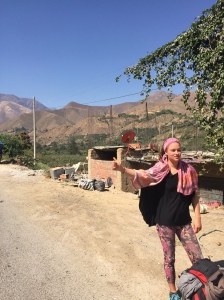
Safety
Like anywhere else it is important to be careful and use plain common sense. Ask which the neighbourhoods you should avoid are. Petty theft and slashing (of bags) happen sometimes. Especially in bigger cities (e.g. Lima) and busses.
Health
Altitude sickness is not felt until you surpass 2500m. It is basically your body telling you it is not getting enough oxygen. Most common symptoms are a headache, nausea and tiredness. In very small number of cases, you could also suffer from significant shortness of breath, confusion, drowsiness, coma and even death. That is why it is very important to give yourself enough time to acclimatise at least a few days. Rest, drink plenty of water and suck coca leaves that many believe helps alleviate altitude’s affect on the body. Available on the market for 1 sol. Once I ate a coca tortilla. After my mouth was numb for a while. Alcohol goes to your head more quickly at higher altitude. So take care with those Pisco Sours.
Climate
The climate in Peru is very diverse. The coast is arid with high temperatures. In the Andes it can get very cold with rainy summers (December to February) and dry winters (June to August). Temperatures tend to drop slightly in the winter. Peru has four seasons. The eastern lowlands present an Equatorial climate with hot and humid weather and rain distributed all year long. I do not recommend visiting the Amazon forest in the rainy season since it is often flooded.
Language
Spanish is the official language although Quechua, Aymara, and other aboriginal languages have co-official status. English is taught in schools. But most people have only a very basic knowledge of English or none at all.
Currency
Official currency: Peruanischer Sol (PEN).
Visa
No entrance or exit fees. The Visa is for 180 days (free).











































































Wow great reading and very informative hope to see many more happy travelling and keep blogging
LikeLike
Very stimulating written, I would like to travel afterwards! I like the good photos, which can be enlarged.
LikeLike
Pingback: Volunteering with Workaway in Central and South America | Minimalist-traveller